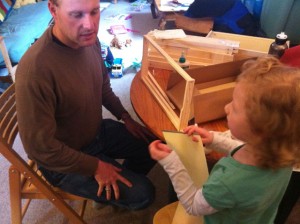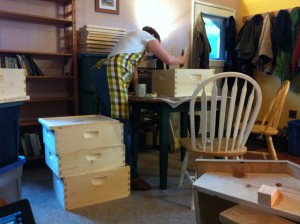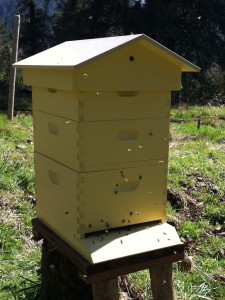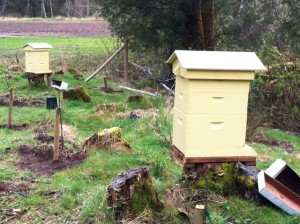We’ve wanted bees on the farm since the very beginning. Besides the obvious tastiness of local honey, we thought it would be helpful to the entire system to have the extra pollination. Farmer Leon next door agreed, and encouraged us to put as many bees as we wanted on the property.
After Bee School and a few informal meetings with Terry, the local bee guru, we got to work. There’s a lot to be done in preparation for having bees. Some stuff should be easy, like ordering the bee suit and smoker. But the bee suit, when it arrived, was too small… and the next size up was out of stock for the next two weeks at both the places in the state that sell it. “OK, just backorder it and send it when you can,” I said.
 Then we got to work building the hive equipment. The hive is a Langstroth hive, a design invented in the 1800s that is so simple and effective that it’s in use almost everywhere and has remained essentially unchanged since then. Basically, it’s a box with hanging frames inside, on which the bees build their comb. Any woodworker could easily fabricate one, but as it turns out, it’s actually cheaper to buy the woodenware pre-cut from a bee supply company than to buy the raw materials yourself. So, hivemaking is basically like putting together a lego set, one of my favorite things! It’s so easy a kid could do it, as demonstrated by Maiwenn, who was visiting us with her dad a few weeks ago.
Then we got to work building the hive equipment. The hive is a Langstroth hive, a design invented in the 1800s that is so simple and effective that it’s in use almost everywhere and has remained essentially unchanged since then. Basically, it’s a box with hanging frames inside, on which the bees build their comb. Any woodworker could easily fabricate one, but as it turns out, it’s actually cheaper to buy the woodenware pre-cut from a bee supply company than to buy the raw materials yourself. So, hivemaking is basically like putting together a lego set, one of my favorite things! It’s so easy a kid could do it, as demonstrated by Maiwenn, who was visiting us with her dad a few weeks ago.
 Once the hives are assembled, you have to paint them on the outside to help them weather years of outdoor service. As is tradition with most beekeepers, I went to the hardware store and looked at their mis-mixed paints on clearance. As luck would have it, i found a heavy-duty exterior paint in a pretty color: lemon yellow! You’re supposed to paint hives light colors to keep them from overheating in the summer. I don’t normally like yellow as a color, but it looks really pretty on the hives. Here’s Emily putting the first coat on the hive boxes (the frames inside do not receive paint).
Once the hives are assembled, you have to paint them on the outside to help them weather years of outdoor service. As is tradition with most beekeepers, I went to the hardware store and looked at their mis-mixed paints on clearance. As luck would have it, i found a heavy-duty exterior paint in a pretty color: lemon yellow! You’re supposed to paint hives light colors to keep them from overheating in the summer. I don’t normally like yellow as a color, but it looks really pretty on the hives. Here’s Emily putting the first coat on the hive boxes (the frames inside do not receive paint).
We set the hives aside to dry, with the idea that we’d paint pretty decorations on the outside in the next few days. Then, Sunday, I got a call from Terry. The bees we ordered through the local beekeeping club would arrive Wednesday morning. Oh no! I called the bee supply store, and had them overnight me a bee suit of the more expensive (but available) “premium” type, figuring that spending the extra $20 would be worth it to have at least SOMETHING to wear while playing with thousands of stinging insects.
The suit arrived just in time, and Terry invited me out to his apiary to help him install the bees in four of his hives (he has about 20 total). The bees come in a warm, humming box about twice the size of a shoebox. Before messing with the bees, we had to set up his hives and fill feeders with syrup for the new bees, since they’d been on the road for a while and were hungry. Once that was done, he pulled on his bees suit.
“Here,” he said as I was hurriedly pulling on my own suit. He held out a pair of exam gloves like doctors wear. “I wear these instead of leather, they let you feel what you’re doing.” My eyes probably bugged out as I imagined my hands in a writhing pile of bees with only .001″ of latex between me and them, but he didn’t see it through the bee veil. When in Rome, do as the Romans do, i guess. I threw my leather gloves back in the truck.
The moment of truth arrived, and he opened the first box of bees. They started buzzing like crazy at that point, and he reached in a pulled out a frame of comb, crawling with bees and filled with brood. It was AWESOME. One by one, he loaded all four hives with bees, and we took off our suits.
“You need to put your bees in today,” he said as we were driving back to his house. I noticed a bee crawling in his hair, and he was totally unconcerned. “I can go out to your site and help, if you’d like.” I thought about the offer, looked at the time, and remembered I still had to go home and get my hives and equipment.
“You know,” I said, ” I think I can handle it, It looks pretty straightforward, and if I have a problem, I’ll call you.” He seemed satisfied with that.
And that is how I found myself out at the farm an hour later, up to my elbow in thousands of bees. I can see why people like beekeeping so much; it’s weird and cool and very relaxing. You can’t hurry with bees, but you have to move purposefully. You must remain calm, so they remain calm. And they’re so darn interesting to watch! It was all very surreal and pleasing, playing with all those buzzing bees as they crawled and hummed and zipped around my head, learning about their new home.
And that is the story of how we got bees.
 UPDATE: I was at out working in the orchard today, day three of the bees, and I was bummed out to see no activity at the hives. But the sun came out, and by noon, the hives were both warming in the full sun and there was a bunch of busy activity! Bees coming and going, zipping around, humming. I sat and watched them for a while, and saw what Terry told me to keep an eye out for: workers returning with their pollen baskets full. It looks like they are already hard at work.
UPDATE: I was at out working in the orchard today, day three of the bees, and I was bummed out to see no activity at the hives. But the sun came out, and by noon, the hives were both warming in the full sun and there was a bunch of busy activity! Bees coming and going, zipping around, humming. I sat and watched them for a while, and saw what Terry told me to keep an eye out for: workers returning with their pollen baskets full. It looks like they are already hard at work.
Click on the photo to get a closeup of the little buzzers.



2 Responses to Bee Home